How many Canadians had a good experience from the care they were provided? How often did doctors and nurses listen carefully to the patient? Are #patients providing input into their care pathway? Did the treatment improve the patient’s health and achieved its desired outcome?
These are important questions to ask because understanding the patient’s view on health service delivery and their perspective on their health status is an essential component of patient-centred care and quality improvement. While patient reported experience measures (PREMs) captures the patient’s view on health service delivery (e.g., communication with nurses and doctors, staff responsiveness, discharge and care coordination), patient reported outcome measures (PROMs) provides the patient’s perspective on their health status (e.g., symptoms, functioning, mental health). PREMs and PROMs are complementary and are meant to be used together to capture a more complete picture of the patient journey.
There has been an increased recognition of the importance of the patient’s perspective in supporting a patient-centered approach to providing quality health care. In Canada, the availability of standardized patient-reported information has been limited. Health service providers, administrators and policy-makers have indicated a desire and need for comparable patient-reported measures to better understand and improve quality of care as well as service delivery and outcomes.
MORE: MAKING PATIENTS OUR PARTNERS
In response to this need, the Canadian Institute for Health Information (#CIHI) has led the development of a pan-Canadian approach for the collection of PREMs for inpatient care and is working closely with jurisdictions across Canada to understand the need to measure patient experience across other sectors. CIHI is also working with several collaborators to lead and facilitate a common approach for PROMs collection and reporting across Canada.
Developing the Canadian Patient Experiences Survey – Inpatient Care (CPES-IC) and Canadian Patient Experiences Reporting System (CPERS)
In 2011, CIHI was approached by several jurisdictions to lead the development of a standardized PREMs survey for inpatient care as there was no other pan-Canadian survey tool to capture patient experience information
CIHI, in conjunction with the Inter-Jurisdictional Patient Satisfaction Group and survey research experts, applied rigorous survey and testing methodology to develop the CPES-IC. National organizations such as Accreditation Canada, the Canadian Patient Safety Institute and the Change Foundation also provided input into the development process
The Canadian Patient Experiences Survey – Inpatient Care (CPES-IC) includes questions from the American Hospital Consumer Assessment of Healthcare Providers and Systems (HCAHPS) survey. HCAHPS was chosen as the base survey as it is a rigorous tool widely used in the United States for over ten years, already adopted in a few Canadian jurisdictions and will allow for international comparisons.
MORE: WHERE WILL THE NEXT GENERATION OF HOSPITAL CEOS COME FROM?
The CPES-IC is administered post-discharge and touches on a number of patient experience themes, some of which include:
- admission and discharge processes;
- communication with nurses and doctors;
- responsiveness of staff; and
- coordination of care.
CIHI built a survey collection database in spring 2014 to house patient experience survey data and as of spring 2015, the system is available to receive CPES-IC data from participating jurisdictions. Together the CPES-IC and CPERS standardizes the collection of patient experience information, ensures the comparability of data from participating organizations and ensures the minimum necessary data elements required for comparative reporting and analysis.
Next Steps for PREMs at CIHI
Implementation of the CPES-IC has already begun in Alberta and Manitoba and CIHI is providing support to additional jurisdictions interested in adopting the CPES-IC. In the near future, CIHI will be providing measures/results back to participating jurisdictions. These reports along with nationally comparative PREMs information will further enrich existing health data to support improvements at the facility and system level.
MORE: TAKING THE MEASURE OF INTERNATIONAL NURSES
CIHI is working closely with jurisdictions across Canada to understand the need to measure patient experience across other sectors
For a copy of the public domain survey and for more information on the CPES-IC and CPERS, please visit www.cihi.ca/prems.
PROMs
In the past year, CIHI has also developed a new program of work focused on PROMs. Similar to PREMs, stakeholders have indicated a desire for CIHI to provide leadership and guide the development of a common approach to PROMs across Canada.
Following an environmental scan of the Canadian and international PROMs landscape in 2014 which revealed variations in existing local and regional PROMs programs, CIHI hosted a pan-Canadian PROMs forum in February 2015 to discuss opportunities to develop a common approach to PROMs in Canada, including common tools and coordinated administration and reporting. The CIHI PROMs Forum was attended by senior policy-makers from federal/provincial/territorial governments, senior health system decision-makers, international guests as well as selected clinicians and senior researchers actively involved in using PROMs. A PROMs background document and the PROMs Forum summary are available at: www.cihi.ca/proms.
Building on the input obtained at the PROMs Forum, CIHI launched a pan-Canadian PROMs advisory committee to support collaboration and inform decisions on PROMs surveys and approaches for data collection and reporting. PROMs demonstration projects and working groups for two priority clinical areas (hip and knee arthroplasty and renal care) are now underway. CIHI will continue to engage in activities to support the availability of comparable PROMs data to Canadians.
For more information on CIHI’s PROMs program of work, visit www.cihi.ca/proms.




